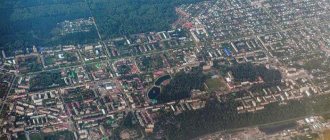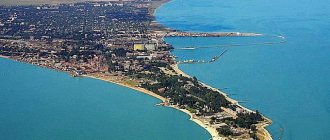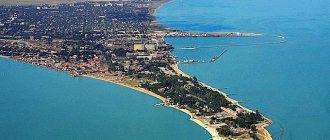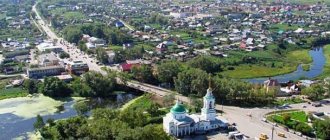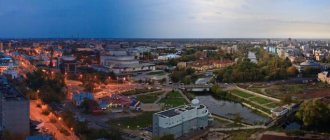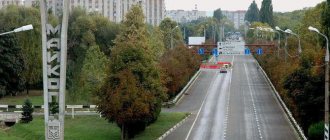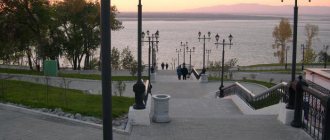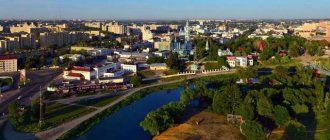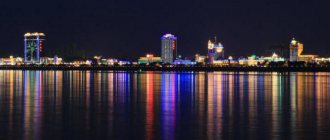The city of Nadym stands on the left bank of the river of the same name. This is the final point of the roads and railways passing through the territory of the Yamal-Nenets Autonomous Okrug. The area of the municipality is 186 thousand square kilometers, and over 44 thousand residents live in it.
The satellite map of Nadym shows that the city is located mainly on flat terrain, but in some places there are small hills and ravines. There are many lakes and other bodies of water around it. Winter in the region comes early and lasts a long time. Frosts in December and January can reach -50 degrees. Summer is short, but in June and July the air can warm up to +25 degrees.
Geographical position
The city of Nadym can confidently be called a circumpolar city in the country, since it is only 1 degree from the latitudes of the Arctic Circle, if you look at the map. The gas production center is located in the Yamalo-Nenets Autonomous Okrug of the Tyumen Region. It is located on the left bank of the small but deep Siberian river Nadym, which carries its waters to the Gulf of Ob.
The flat terrain where Nadym is located opens up the vastness of the West Siberian Plain. It occupies the territory from the Ob to the Yenisei. The time difference between Moscow and Nadym is 2 hours.
Map
| Nadym: maps |
Nadym: photo from space (Google Maps) Nadym: photo from space (Microsoft Virtual Earth)
| Nadym. Nearest cities. Distances in km. on the map (in brackets along roads) + direction. Using the hyperlink in the distance , you can get the route (information courtesy of the AutoTransInfo website) | |||
| 1 | Pangodas | 96 (134) | IN |
| 2 | Yar-Sale | 165 () | NW |
| 3 | New Urengoy | 199 (226) | IN |
| 4 | Muravlenko | 216 (626) | SE |
| 5 | Gubkinsky | 223 (499) | SE |
| 6 | Purpe | 229 (491) | SE |
| 7 | Aksarka | 241 () | NW |
| 8 | Tarko-Sale | 254 (433) | IN |
| 9 | Urengoy | 271 (308) | IN |
| 10 | Salekhard | 287 () | NW |
| 11 | Noyabrsk | 295 (661) | SE |
| 12 | Labytnangi | 302 () | NW |
| 13 | Harp | 332 () | NW |
| 14 | Beloyarsky | 344 () | SW |
a brief description of
Located in the north of Western Siberia, on the Nadym River, 563 km southeast of Salekhard, 1225 km north of Tyumen.
Territory (sq. km): 307
Information about the city of Nadym on the Russian Wikipedia site
Historical sketch
Mentioned at the beginning of the 20th century. as a trading place on the right bank of the river. Nadym (flows into the Ob Bay). Now this is the village of Stary Nadym.
The name Nadym was given to the city, formed in 1972, located on the left bank of the Nadym as a large center of gas production, the end point of the inactive railway from Salekhard.
A number of etymologies have been proposed for the hydronym Nadym, the most realistic of which are from the Nenets nyady - “moss moss” and from the Nenets dialect nado - “yar”; steep steep bank"; the existence of the generic name nadangga (“newcomers”) is also allowed.
Municipal indicators
| Index | 2001 |
| Demography | |
| Number of births, per 1000 population | 10.7 |
| Number of deaths, per 1000 population | 5.5 |
| Natural increase (decrease), per 1000 population | 5.2 |
| Standard of living of the population and social sphere | |
| Average monthly nominal accrued wages, rub. | 13654 |
| Average housing area per inhabitant (at the end of the year), sq.m. | 21.4 |
| Number of preschool institutions, pcs. | 11 |
| Number of children in preschool institutions, thousand people | 2.1 |
| Number of daytime educational institutions (at the beginning of the school year), pcs. | 10 |
| Number of students in daytime educational institutions, thousand people | 8.3 |
| Number of doctors, people. | 351 |
| Number of nursing staff, people. | 950 |
| Number of hospital institutions, pcs. | 7 |
| Number of hospital beds, thousand units | 0.8 |
| Number of medical outpatient clinics, pcs. | 19 |
| Capacity of medical outpatient clinics, visits per shift, thousand units. | 2.4 |
| Number of registered crimes, pcs. | 1073 |
| Persons who committed crimes were identified, persons. | 836 |
| Economy, industry | |
| Number of enterprises and organizations (at the end of the year), pcs. | 1120 |
| Construction | |
| Volume of work performed by type of activity “Construction” (until 2004 - volume of work performed under construction contracts), million rubles. | 18600.1 |
| Commissioning of residential buildings, thousand sq.m. of total area | 0 |
| Commissioning of residential buildings, apartments | 0 |
| Commissioning of preschool institutions, places | 0 |
| Commissioning of educational institutions, places | 0 |
| Commissioning of hospital facilities, beds | 0 |
| Commissioning of outpatient clinics, visits per shift | 0 |
| Transport | |
| Number of bus routes (in intracity traffic), pcs. | 6 |
| Number of passengers transported by buses per year (in intracity traffic), million people. | 4.9 |
| Connection | |
| Number of residential telephone sets of the city public telephone network, thousand units. | 16.2 |
| Trade and services to the population | |
| Retail trade turnover (in actual prices), million rubles. | 2018 |
| Retail trade turnover (in actual prices), per capita, rub. | 45557 |
| Public catering turnover (in actual prices), million rubles. | 132 |
| Volume of paid services to the population (in actual prices), million rubles. | 452.1 |
| Volume of paid services to the population (in actual prices), per capita, rub. | 10205 |
| Volume of household services to the population (in actual prices), million rubles. | 19.7 |
| Volume of household services to the population (in actual prices), per capita, rub. | 445 |
| Investments | |
| Investments in fixed assets (in actual prices), million rubles. | 473.7 |
| Share of investments in fixed assets financed from budgetary funds in the total volume of investments, % | 44.6 |
Data sources:
- Regions of Russia. Main characteristics of the constituent entities of the Russian Federation: statistical collection. Goskomstat of Russia. - M:, 2003.
Economy
Natural gas production (Medvezhye field).
Large-panel house-building plant.
Nadym is the beginning of the gas pipeline system North of the Tyumen region - Ural - Volga region - Center.
Main enterprises
NATURAL GAS PRODUCTION
LLC "Nadymgazprom"
626730, Yamalo-Nenets Autonomous Okrug, Nadymsky district, Nadym, st.
Zvereva, 1 Offers:
natural gas
BUILDING MATERIALS INDUSTRY
JSC "Nadymsky ZKPD"
626711, Yamalo-Nenets Autonomous Okrug, Nadymsky district, Nadym, st.
Zavodskaya Offers:
Prefabricated reinforced concrete structures, parts for large-panel housing construction, wall materials
Universities of the city
Moscow Psychological and Social Institute (Nadym branch)
629730, Yamalo-Nenets Autonomous Okrug, Nadymsky district, Nadym, Zavodskaya st., 7-A
Siberian State University of Physical Culture and Sports (Nadym branch)
629730, Yamalo-Nenets Autonomous Okrug, Nadymsky district, Nadym, st. Geologists, 4/1
Tyumen State University (Nadym branch)
629730, Yamalo-Nenets Autonomous Okrug, Nadymsky district, Nadym, emb. them. Orujeva, 58-a
Branch of Tomsk State University of Control Systems and Radioelectronics in Nadym
629730, Yamalo-Nenets Autonomous Okrug, Nadymsky district, Nadym, Leningradsky Ave., 6
Branch of the Tyumen State Oil and Gas University in Nadym named after. V.V. Remizova
629730, Yamalo-Nenets Autonomous Okrug, Nadymsky district, Nadym, Komsomolskaya st., 15-a
Museums, galleries, exhibition halls
House of Nature 629730, Yamalo-Nenets Autonomous Okrug, Nadymsky district, Nadym, Parkovy proezd, 1 Phone(s) Website: https://nadym-museum.ru/
Museum of History and Archeology of Nadym 629736, Yamalo-Nenets Autonomous Okrug, Nadymsky district, Nadym, Leningradsky pr., 11 Phone(s): (3499) 53-6981 Website: https://nadym-museum.ru/
Museum of the history of the enterprise LLC "Yamburggazdobycha" 629740, Yamalo-Nenets Autonomous Okrug, Nadymsky district, Yamburg village, Cultural and sports complex Telephone(s): 34949) 6-97-76
| Population by year (thousands of inhabitants) | |||||||
| 1979 | 26.1 | 2001 | 44.4 | 2010 | 46.9 | 2016 | 44.9 |
| 1989 | 52.6 | 2003 | 45.9 | 2011 | 46.6 | 2017 | 44.7 |
| 1992 | 51.1 | 2005 | 49.2 | 2012 | 47.4 | 2018 | 44.6 |
| 1996 | 47.8 | 2006 | 48.8 | 2013 | 46.8 | 2019 | 44.7 |
| 1998 | 47.2 | 2007 | 48.5 | 2014 | 45.8 | 2020 | 44.8 |
| 2000 | 44.9 | 2008 | 48.2 | 2015 | 45.8 | 2021 | 45.6 |
Climate Features
An ocean of snow, a strong, biting frost and an endless polar night - this is how the local population describes the climate. Geographically, Nadym is located in the subarctic continental zone, where winters are harsh and long, and summers are short and cool with a large number of mosquitoes and midges. The flat area where Nadym is located allows for unhindered passage of air masses. Cold ones “come” from the Kara Sea, and hot ones from the expanses of Central Asia. Together they influence the weather, causing sudden changes. The amplitude of the indicators is about 90 °C, where the average cold temperatures in January are 23 °C, and in July + 15 °C. It happened that the harsh region was shackled by frosts with an indicator of -62 ° C and northern winds with a speed of up to 15 m/s.
Historical data
The toponym of the object is directly related to the name of the local river. Translated from the Nenets language, the city of Nadym means “a land rich in reindeer moss” (a lichen loved by reindeer).
The first mention of the village, lost in the tundra, appeared in the Mezen Chronicle of the 16th century, and the settlement received city status in 1972, thanks to the development of gas fields in the Tyumen North. The fortification, created near the river, was a wintering place for hunters, fishermen and reindeer herders. The indigenous population of the area where Nadym is located has improved the technology of making utensils and jewelry from copper, tin, leather and wood. But the leading and most popular occupation for the Far North was reindeer breeding and fishing. The permafrost perfectly preserved the memory of the first inhabitants of the fortification. This is proven by archaeological excavations and an abundance of all kinds of finds - children's toys made of mammoth ivory, jewelry, boats, skis for hunters, kitchen utensils and woolen clothing, bladed weapons and crossbows.
The modern history of the region where Nadym is located tells of its development and prosperity, because the stronghold of gas fields has a good location for air transport. Hundreds of kilometers of forests and marshy areas are a natural barrier. The history of Nadym is stitched with a “black thread”, but today only the ruins of Stalin’s camps remind of the construction of the “Dead Road” connecting the settlements of Chum, Salekhard, Nadym, Igarka.
Economic potential
The leading sectors of the city's economy are gas production, oil enterprises and gas transportation systems. Nadym is the first hub city in Russia for the extraction of fuel and energy resources and the country’s most powerful gas base. The Nadymneft and Gazprom Dobycha Nadym enterprises account for 96% of the total industrial output of the northern city. It is here that a tenth of all Russian gas is produced.
The town of fifty thousand also has a well-developed construction industry, which is of no small importance for replenishing the budget of the locality. Energy is considered the most promising area of investment in the city; it is the basis and income of Nadym.
In addition to fossil fuels, the city of Nadym is also rich in large forest reserves. The harsh and at the same time beautiful settlement of the endless North has a high standard of living for its citizens, a well-developed infrastructure and many prestigious awards. His achievements are prosperity and economic stability.
Nadymsky district
- Home"
- Nadymsky district"
- City of Nadym
“It was Nadym that stood at the source of the “gas river”
and gave a powerful impetus to the intensive development of subsoil”
Member of the Federation Council of the Russian Federation Yuri Neyolov
Nadym
Administrative unit: city, district center. Received city status on March 9, 1972.
Geographical location: 65th parallel of northern latitude, located in the central part of the Yamalo-Nenets Autonomous Okrug, 100 km south of the Arctic Circle.
Climate: subarctic continental with long (up to 8 months) harsh winters. The average annual temperature is -6.40C, the absolute minimum is 620C, the absolute maximum is +350C.
Postal address: 629730, Russia, Yamalo-Nenets Autonomous Okrug, Nadym.
Population: about 45 thousand people.
The basis of the economy is formed by gas and oil production and gas transportation enterprises.
More than 40 years ago, when the need arose to create a base for the industrial development of the north of Western Siberia, it was decided to locate it on the territory of the Yamalo-Nenets Autonomous Okrug. The main idea was to create large modern cities in the most favorable places for living. This concept determined the fate of the half-forgotten village of Nadym, lost in the tundra, which became the first base city for the development of the fuel and energy base of the entire country.
On March 9, 1972, in accordance with the Decree of the Presidium of the Supreme Council of the RSFSR, the village of Nadym, Nadym district, Tyumen region, Yamalo-Nenets national district, received city status and became the center of the Nadym region.
Within the first 10 years, Nadym turned into the country's most powerful gas base. In a matter of years, residential and industrial buildings, gas fields, power lines, pipelines, factories, roads were built - a territory equal in area to a European state was populated and developed.
Modern Nadym is one of the most beautiful cities in the Far North with a special architectural appearance and developed infrastructure. It is known as one of the centers of cultural, scientific, and medical life of the Yamalo-Nenets Autonomous Okrug. The city, home to about 45 thousand people, has a full range of cultural and sports facilities, 7 secondary schools, a gymnasium, a vocational school, and two art schools.
In recent years, Nadym has seen an increase in the birth rate; more than 600 babies are born annually. The growing birth rate is real evidence of the high standard of living in the city, which the third generation of Nadym residents consider home.
Today, in terms of population, the city is in 3rd place among the cities of the Yamal-Nenets Autonomous Okrug. The city is home to 70% of the population of the Nadym region.
Nadym is the winner of many prestigious and honorary awards.
In 2001, the city of Nadym received a third degree diploma from the Government of the Russian Federation in the All-Russian competition for the title “The most comfortable city in Russia among small towns.” In 2002, Nadym was recognized as “The Most Comfortable City in Russia” for its good work in developing the urban economy. Nadym is also the holder of a certificate in the nomination “The best city of the Russian Federation in terms of economic indicators of financial development in 2003” in the category of small cities of the All-Russian competition “Golden Ruble” for the Ural Federal District.
“Nadym-2005” was the name given to the ninth-magnitude Blue Star in the constellation Pisces, for which the city was awarded a unique certificate confirming its entry into RosAstro’s catalog of celestial bodies.
Today Nadym is an intellectual center for the development of the territory, accumulating the economic, power, financial, and creative potential of the Nadym Land. It is growing, becoming prettier, developing dynamically and making a worthy contribution to the sustainable development of the economy of Yamal, the Ural Federal District and Russia.
How to get to Nadym?
The distance between Moscow and Nadym is 3040 km, along highways – 3888 km. You can get to the polar city by air, covering the route in 3 hours 10 minutes. This is the fastest and most popular way to get to the village. There are 6 direct flights between the cities: from Domodedovo by plane, and from Vnukovo by Gazpromavia.
There is no direct connection between Moscow and Nadym by rail. You need to take train 012Ya to Novy Urengoy, and then the journey will continue by bus. The route time will be 2 days 18 hours to Novy Urengoy and another 4 hours to Nadym.
Due to the distance between cities, there is no bus service. A trip by personal car will not only be tiring, but also expensive - about 50 hours on the road to cover a distance of almost 4000 km.
Streets of Nadym on the map
The map of Nadym with streets notes that the city has 14 microdistricts, 10 passages, 42 streets, 2 squares, and several villages. The main highways are:
- Zvereva;
- Komsomolskaya;
- Leningrad Avenue;
- Cedar;
- Polar.
There is no administrative division into districts in the city, but local residents divide its territory into three parts - Central, Left Bank and Right Bank (Old Nadym). A bridge connects the banks. On the detailed map of Nadym it is noted that the Salekhard-Nadym highway passes through it, which ends at the airport of this regional center. A railway runs along the borders of Nadym. Buses run in the city on 7 routes. The Nadym River is navigable, and there is a port in the city.
The municipality has a significant number of multi-apartment residential buildings built in the 50s of the last century. At the same time, depot buildings, a power plant, a hospital campus and some other infrastructure facilities were also built. In the late sixties and early eighties, housing construction continued.
On the territory of Nadym there are many high-rise panel buildings typical of that period of construction. There are also buildings in the city that were erected after the collapse of the USSR. In some microdistricts of Nadym, the construction of high-rise buildings continues today. For example, the Olimpiysky microdistrict, consisting of thirteen nine-story buildings, recently grew there.
Population
The city's population is 44,660 people. Russians, Ukrainians, Tatars, Khanty, Komi and Nenets - this is the predominant national composition of the city of Nadym. The population was formed by representatives of the former republics of the USSR and other regions of Siberia. But today the demographic and labor potential of the city’s residents is significantly different from the previous one. According to statistics from the Yamal-Nenets Autonomous Okrug, 48.3% of men and 51.7% of women live in Nadym. The working population in the city is quite high and averages 70.7%, elderly people make up only 2.7%. Harsh climate conditions cause the emigration of people of non-working age, and the percentage is acceptable to the indigenous peoples of the area. Nadym, whose population has decreased significantly compared to 2010, ranks 4th among the settlements of the Autonomous Okrug.
Tourist opportunities
The city of Nadym in the Yamalo-Nenets Autonomous Okrug had a permit entry for a long time, and ordinary tourists were not allowed to visit. Today he is full of life. In addition, not every tourist center in the country can take guests on a reindeer ride to the Arctic Ocean, organize a photo hunt for the Arctic wolf and white fox, and show them what the polar night is like.
Tourists will be interested in studying the traditional life of the indigenous people. Sit in the Nenets chum, take part in sledge competitions, witness ritual holidays or celebrate spring in the tundra - all this is possible upon arrival in Nadym.
Brief history of the Nadym region
Having survived the transformations of the twenties and thirties, by the next decade the Yamalo-Nenets Okrug had firmly become an integral part of the new political and economic system. The Nadym region has fully developed as a separate administrative-territorial unit with its own system of administration, medicine, education and propaganda. Connections were established between new economic units, transport and postal services worked.
By the beginning of the 1940s, in the Nadym region there were six stationary settlements that had the status of a village: Kutopyugan, Yartsangi, He, Shuga, Nori, Nyda. In addition, there were trading posts and camps: Varkuta, Nadym, Khambi-Yakha, Olensovkhoz, Khus-Yakha, Syadai-Kharvutta, Ezelovo, Ader-Payuta, Yamburg. All settlements were part of two village councils, both Nenets, national. The predominant population was Russians, the Nenets were in second place, the Khanty were in third, and the Zyryans were in fourth place. The regional center was the village of Nyda.
In the area there was one fish factory, one state farm and three collective farm associations, including two mixed production artels and one simple production association. Farms, as a rule, simultaneously engaged in fishing, reindeer herding, and hunting. Of the total gross income of the population, fishing accounted for 35.5%, hunting - 14.1%, and reindeer husbandry - 34.9%. Livestock farming gradually developed. By the beginning of the forties, there were 107 cows, 68 pigs and 61 horses in the area. The number of domestic reindeer exceeded thirty thousand heads. On average, there were less than fifty animals per farm. Thus, the predominant role of fish production and fish processing remained in the area.
The education system in the area consisted of three elementary schools with 108 students and one junior high school with 100 students. The children were taught by a dozen and a half teachers. In the area there were three postal agencies, three mailboxes, 65 radio points, 4 radio stations. Village councils were connected by radiotelegraph to the regional center. And the center of the district - the village of Nyda - was connected by radiotelegraph to the regional center, which until 1944 remained the city of Omsk.
The war with Nazi Germany meant for our region, as well as for the whole country, the mobilization of forces and means for the fight, the departure of part of the population to the front and the death of people.
On the eve and during the war, people were forcibly resettled from the regions of Western Belarus, Bessarabia, the Baltic states, and the Volga region to the territory of the European and Siberian North. In 1942, a new wave of special settlers from the territories of Western Ukraine and Bessarabia arrived in the Nadym region. Their initial housing was the dugouts and half-dugouts they dug. Many families, for example, in Nyda lived in them until the end of the forties. Their living and working conditions caused high mortality rates.
Fulfilling the tasks of difficult wartime was complicated by the low educational level of the indigenous population, a significant part of which was illiterate and did not speak Russian. At the front, this low educational level, as well as the lack of understanding of modern technology, and indeed of modern life with its rhythm, system of subordination and other features, made the tundra inhabitants those soldiers who found it difficult to survive in battle conditions. In particular, this led to a large proportion of missing persons.
There was a health care system in the area: at the beginning of 1942 there were two hospitals - in the villages of Nyda and Shuge (with 25 beds each), two medical outpatient clinics - in the villages of Nori and Kutopyugan, and four paramedic stations. Moreover, during the period from January to April 1942, a medical assistant station was opened at the Nadym and Vanuito trading posts. This network of medical institutions was served by four doctors, twenty-six nurses and midwives. At this time, construction continued in populated areas of the region. Thus, a new boarding school was built in Kutopyugan, and construction began on a 15-apartment building and a bathhouse in Nyda. At the end of 1942, there were nine schools in the area with 393 students. Including 120 people in the Nyda junior high school, 7 in the Vanuitinsk primary school, 88 in the Shuginsk junior high school, 15 in the Numga primary school, 40 in the Norinsk primary school, 31 in the Khenskaya primary school, 60 in the Kutopyugan primary school, and 32 in the Nadymsk primary school. 33 pupils lived in the boarding school. A text report from the Nadym district department of public education for the 1944/45 school year recorded 4 boarding schools and already 466 students in nine schools in the district.
Life for students and teachers was very difficult. A chronic problem was the lack of heat in the premises; there was an acute shortage of clothing, shoes, beds and bedding. Scabies and lice were a constant scourge among schoolchildren.
A separate concern of local authorities was political education, or rather, political propaganda, which was important for social stability and support for the spirit of citizens. This was strictly monitored by the entire vertical of power.
Here, for example, is what one of the documents from 1944 tells about: “Political and educational work is carried out from time to time by visiting workers from the region. Local activists are doing extremely little, and in carrying out explanatory work, gross shortcomings were committed last year in 1943, which have not been corrected to this day. Last year, it was found that the chairman of the Nyadongi collective farm, when conducting conversations about the current moment of the Patriotic War, perceived less the heroic exploits of the Red Army, and more the atrocities committed by the Nazis against civilians and Red Army soldiers who were captured. In a conversation with collective farmers, he portrayed the Nazi soldier as an invincible beast and exaggerated the strength of the German army and its weapons, which created fear among individual collective farmers, a fear of joining the Red Army. This explains the escape into the tundra in 1943 of conscripts Vello Libi and Vello Yabi. This misunderstanding still exists today, as can be seen from the above statement by collective farmer Ivan Larakh and a number of other facts. Mass work is carried out without the use of visual aids and other materials. As a result, it is less convincing and less effective. The residence of the collective farm board and the trading post are located in the village of Nadym, where the imported contingent settled: Romanians, Moldovans, Germans. The plague of collective farmers is also located near this village. Due to the constant communication of collective farmers with special settlers, there is also a negative impact on collective farmers.”
No less interesting is another document reflecting the mood of Nadym residents a year before the end of the war:
“Report to the Secretary of the Republic of Kazakhstan All-Union Communist Party of Bolsheviks, Comrade Bisarev.
During conversations and meetings, collective farmers held conversations and asked the following questions: 1. What will be the post-war regime in Germany; 2. There is no need to give the Germans a break, otherwise they will recover and again exterminate the people; 3. In order for there to be no war in the future, it is necessary to destroy all the big Germans, to leave alive those who are now only sucking milk; 4. When Hitler is caught, he must be brought to every collective farm and beaten, and then killed to death.
All this speaks of the increased patriotism of collective farmers, of their readiness to help the front with all their might.
20.V.44 Puminov.”
The population of the area, especially the old-timers, who were less disadvantaged than the special settlers, sought to support the soldiers at the front not only by working in production. People sent parcels to the front, donated money and warm clothes to the defense fund.
As the district newspaper later reported, “During the war years, the Nadymsky district handed over 110,707 quintals of fish to the state, including 12,000 quintals to the general command fund. Furs and fur raw materials worth 1,826,200 rubles were delivered to the state. The subscription to state loans of the working people of the region is 2,649,000 rubles; in 1946 it was expressed at 544,000 rubles, of which 457,000 rubles were paid in cash.
The population of the region handed over 4,332 items to the front, 7,007 rubles in cash, 74 gold items, 47 silver items, and 4,109 live deer. Collective farmer of the Lenin collective farm Vanuito donated 10,000 rubles in cash to the defense fund.
District workers collected 110,667 rubles for the children of front-line soldiers and disabled war veterans. During the war years, the collective farm herds grew by 2,996 heads of deer; for the last three years, the region has exceeded its fish production plan, won championship in the district and region, and received several all-Union awards. Over the past two years, the district has been the first in the district to fulfill the fur procurement plan.”
Of the Nadym residents who participated in the battles, the name of Anatoly Zverev, Hero of the Soviet Union, the son of those “dispossessed” and resettled from near Astrakhan to the village of Shuga in the Nadym region, is the most widely known. But here are other names. The October 1945 issue of Krasny Sever reported: “Recently, the workers of the region met five front-line girls who had returned to their homes. These girls Maria Alekhanova, Galina Solntseva, Maria Porotikova, Galina Ryauzova and Maria Bogdanova walked a glorious path with weapons in their hands, fighting the Nazi invaders.”
In terms of work and life, the post-war period was no easier than the war days. Workers, employees, and collective farmers were forced to respond to government decisions on the issue of government loan bonds. With meager incomes, they signed up for loans in amounts amounting to two, three, or even four monthly salaries.
The tone of the first post-war newspaper publications about life in the Nadym region was businesslike, but calm. But in 1947, the tone of publications changed in many ways. A government decree was issued to strengthen the fight against theft of state and collective farm property. A new “call” reached the camps. Newspaper headlines in 1947 said that the fight against wolves in the region was poorly conducted, which is why the losses of reindeer herd were high. It was reported that violations of the “Charter of Agricultural Associations on Collective Farms” were slowly being eliminated. For violations, the head of the district land department, Shulepov, was dismissed from his job, and the chairman of the executive committee, Puminov, was reprimanded. The Shuginsky fish factory was criticized for its poor preparation for poutine. And to add insult to injury, that year the district failed the fur harvesting plan, although before that it had been the leader in fur harvesting in the district for two years.
The post-war years saw the heyday of the agricultural activity of Nadym residents. The Nydinsky reindeer state farm and the zonal station stood out for vegetable growing, where, by northern standards, they obtained high yields. And even flowers were grown. In the village of Nori, collective farmers grew oats, peas, tobacco, tomatoes in greenhouses and other vegetables. In the then small village of Nadym, water metering observer Mukhin was working on barley crops. In 1945, tobacco was planted on the Nyda reindeer farm. In addition, potatoes, turnips, and carrots were grown there.
In the post-war years, some favorable changes occurred in the area in terms of transport and equipment. The number of fishing and receiving fleets in the fishing industry grew. In addition, floating stalls and traveling boat stalls were organized to serve fishermen at fishing sites.
The Nadym newspaper “Kommunist” joyfully reported: “Until 1955, the fishing artel named after. Lenin did not have mechanization. The means of transportation were sail and rowing. This year (1958) a DT-54 crawler tractor was purchased.” On September 1, 1959, the motor ship OM-341 appeared in the Yamalo-Nenets District and began making trips along the Ob Bay. Later it was joined by OM-342.
Fishing remained the main economic sector in the region during the war and in the post-war period. During the war years, catches increased sharply. In 1950, to service the fishing collective farms of the Nadymsky and a number of collective farms of the Yamal districts, the Nizhny Ob Motor Fishing Station (MRS) was created. It provided collective farms with fishing gear, rowing and motor fleets. And yet the life and work of fishermen remained very difficult. Life remained at the most wretched level, and work was almost hard labor. Here is what a regional newspaper wrote about one fishing trading post in 1949: “The premises, including warehouses, are dilapidated and in ruins. The roofs are leaking. Many windows do not have glass. The oven in the bakery needs immediate major repairs. There are no clocks at the trading post, there is only one smokehouse lamp, and there are absolutely no dishes in the teahouse. For visitors there is only one mug and two trestle beds with bedbugs and cockroaches.”
In the 1950s, electrification of Nadym villages was carried out, but it did not affect those who lived in numerous fishing camps. A significant role in making life easier for fishermen at that time was played by the increase in acceptance prices for raw fish from July 1, 1950 by an average of 45%, and for whitefish by 60%.
To organize “cultural recreation” and ideological influence on the population in the region, there were “Red Chum”, clubs, reading huts, where one could borrow newspapers, magazines, and books. A regional cultural center was built in Nyda, and a radio was operating. The first collective farm radio center in the region was created in the village of Yartsangi in October 1954.
Various study circles, including political ones, were created. For example, at the collective farms and the Nyda deer farm there were study groups for the study of the “Short Course in the History of the All-Union Communist Party (Bolsheviks).” Even sellers at trading posts were required to carry out cultural work. The effect was usually zero. From time to time, the authorities organized various sports competitions and amateur art shows in villages, most often in Nyda. Lecturers traveled around the area giving lectures and conversations.
In the mid-fifties, the network of cultural and educational institutions in the region was already quite extensive, but their material base remained weak.
Schooling was a particular problem. In the late 1940s and early 1950s, the party leadership began to worry about the fact that the law on universal education was not being implemented in the region. Not all children were enrolled in even primary education, let alone seven years of age. And if Nenets children studied in primary school, then after graduation, as a rule, they left with their parents for the tundra.
At the end of the 40s, the national personnel crisis worsened again. As noted at the III plenum of the district committee in September 1950, in the region “not a single Nenets worked as chairman of a collective farm, village council, head of a department of the executive committee of the district council or district committee of the All-Union Communist Party of Bolsheviks.”
A feature of the time was a shortage of industrial goods, although food products were not very diverse even in the eyes of the undemanding Nadym population. For example, fresh fish and meat were very rare in stores. We have only heard about smoked meats and sausages. In the second half of the 50s, the situation largely improved. The retail network expanded, and specialized hardware stores appeared. Canteens opened.
During 1961–1962, in the Nadym region, according to a resolution of the Council of Ministers of the RSFSR, a Nadym reindeer herding state farm was created on the basis of a reindeer state farm (village Numgi) and two collective farms (named after Stalin in Nyda and Rodina in Nori). Part of the farms of two other collective farms was merged into the state farm: “Industrialist” (center - He) and them. Lenin (center - Kutopyugan). On the basis of the collective farm named after. Lenin, the Kutopyugan fish section of the Puykovo fish factory was created.
As a conclusion, it can be noted that in the forties and early sixties, the life of people in the old villages of the region finally acquired the form that it basically retained until the end of the twentieth century.
In 1965–1968, the Tyumen complex expedition of the Faculty of Geography of Moscow State University conducted research on the territory of the district. In the region, the villages of Nadym (now Stary Nadym) and Nyda became collection points for materials. Many aerovisual, as well as land and water routes ran through the territory of the Nadym region from the then Nadym to the Khorovaya trading post, from there to the northeast through Nyda along the entire coast of the Tazovsky Peninsula and to the west along the southern bank of the Nadym Ob through Shuga, Yartsangi, Kutopyugan to Salekhard . In addition, walking routes and collection of materials were carried out in areas in the upper reaches of the Nyda, Pravaya Khetta and Heigiyakha rivers. The result of comprehensive research by geographers was the publication “Atlas of the Tyumen Region”.
In 1966, geologists discovered a structure with high gas content in the Nadym tundra. The following year, gas was obtained from the Nydinskoye and Medvezhye fields, the total reserves of which were estimated at 800–1,000 billion cubic meters. Work was carried out at a rapid pace at the Urengoy field.
One of the participants in the events, in a letter written to Tyumenskaya Pravda, recalled the beginning of a new era in Nadym: “I remember well how seismicists from Volodya Avdeenko’s party appeared here. And the quiet trading post of Nadym began to seethe with new settlers. The old-timers greeted people warmly. The apartments of the Mukhins, Miglanovs, Sergeevs and Komarovs turned into dormitories. It was tight, but fun."
On June 6, 1967, by order of Glavtyumengeology, a self-supporting Nadym oil and gas exploration expedition was organized on an independent balance sheet, located in the village of Nadym, which thus became one of the country’s raw materials centers.
Photo courtesy of Nadezhda Gritsenko
Vadim GRITSENKO
Interesting sights
The main shrine of the city is the Church of St. Nicholas the Wonderworker. This is a noteworthy Orthodox church, built in Nadym in 1998. The religious building is decorated with five ribbed domes, has clear geometric proportions and is painted in warm colors. The combination of white and yellow gives the temple a sunny warmth and brightness amidst the harsh winter conditions. The pride of the shrine is the wooden carved iconostasis.
The Museum of History and Archeology of the city houses exhibitions of cultural, everyday and historical values of the northern region. There are exhibitions of Nenets ethnography, nature, minerals and medicinal plants, and political events. The exposition “Miadomti Mya” deserves special attention. Tourists are presented with a picture of the life and everyday life of the indigenous population, the culture and traditions of the nomads who lived in the plague. The museum organizes events on the topic of studying the life of the Nenets. Thus, in March a competition of reindeer herders is held - a colorful and impressive spectacle.
The young northern city is landscaped with parks, playgrounds, art sculptures and modern monuments. Nadym itself is an important landmark of the Far North.
